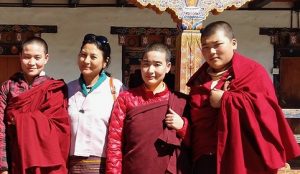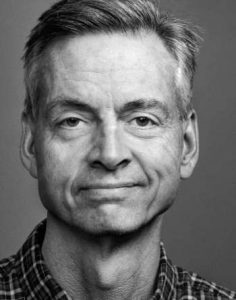Ajahn Buddhadasa (1906–93) was a well-known and respected ascetic-philosopher from Thailand. Buddhadasa means “Servant of the Buddha.” Buddhadasa promoted a reform of traditional religious perspectives in his country and abroad. He was renowned for his creative reinterpretations of Buddhist doctrine.
Buddhadasa was born as Nguam Panitch in the reign of Chulalongkorn (Rama V of the royal house of Chakri). His mother, a devout Buddhist, was the one who initially sparked his interest in Buddhism. His mother’s friends and monks would frequently meet at her shop to talk about religious matters, including whether heaven and hell exist, the nature of good and evil, and observing the precepts. During their conversations, Nguam reportedly started to question why so many people had held onto these beliefs for so long if they were not all really true.
When Nguam was 10 years old, his parents took him to live at Wat Pum Riang monastery, where he spent three years as a temple boy. On several occasions later in life, Buddhadasa would have warm recollections of his time spent with other temple boys as he learned the virtues of selflessness, cooperation, hard work, timeliness, and responsibility. In his book A Single Bowl of Sauce Solves All the World’s Problems, he suggested that this simple way of traditional education for boys could be a means of overcoming the immorality and greed wreaking havoc on the planet.
After spending a few years studying as a bhikkhu in Bangkok, he became convinced that, in his words, “purity is not to be found in the big city.” This led him to live nearer to nature in order to investigate the Buddha’s Dhamma. In close proximity to his village of Pum Riang (now in Chaiya District), he established Suan Mokkhabalarama (The Grove of the Power of Liberation) in 1932. Over the years, the reputation of Buddhadasa, his writings, and Suan Mokkhabalarama grew and became one of the most influential Buddhist centers in Thailand.
Buddhadasa was by no means insular. He was mindful of the “Protestant” fever sweeping religious scholars of different traditions of his day. There was an urge to “get back to basics,” and return to an original ur-faith hidden underneath the many layers of culture, superstition, and politics that had accrued over the millennia and misled sincere believers. The accurate and fundamental elements of Buddhist teachings were what Buddhadasa referred to as “pristine Buddhism,” the Buddha’s initial realization before it was obscured by commentaries, ritualism, clerical politics, and other factors. His work was based on in-depth analysis of the Pali texts, particularly the Sutta Pitaka, which contains the Buddha’s Discourses, as well as his own experimentation and application of these teachings.
Buddhadasa interpreted the Tipitaka in accordance with what he saw as the fundamental teachings that the Buddha was most likely to have preached in some form: the four noble truths, no-self, and dependent co-arising. He reasoned that all of these fundamental teachings were more cohesive and made more sense in light of one another. This meant that he deviated from the dogma of traditional Thai doctrine. He focused on the present moment and the spiritual aspects of daily life, a healing of the lay-monastic rift, greater compatibility with science, increased intellectual rigor, and the reintegration of political and social issues within a Dhammic worldview of no-self.
Buddhadasa studied all branches of Buddhism in addition to the other major world religions. This interest wasn’t academic but rather practical. Under the dramatically-worded strategy of “drag humanity out from under the power of materialism,” he aimed to bring all sincere religious people together. Because of his open-mindedness, he made friends with people of all faiths, including Christians, Muslims, and Hindus.
Buddhadasa used the term “spiritual” in a way that included the material, physical, and social. Spirituality does not reject the body, society, economy, politics, or any other aspect of existence, but rather understands all of its facets in the context of Dhamma. He noted:
Buddhism is neither materialism or mentalism, but is the correctness between the two or is both of them in the right proportions. The religion which can be taken as the best social science must not be a slave of materialism nor crazy about mental things.
(Bhikkhu Santikaro 1996, 155)
Buddhadasa defined dukkha (suffering) as the experience of anxiety, disputes, ugliness, dissatisfaction, meaninglessness, and imperfection. He claims that only by giving up all egoism and attachment will dukkha be finally eliminated. There will be no more dukkha, no more birth, and no more death when we have no thoughts of “me” or “mine” toward anything in the universe, including our consciousness.
Achieving peace in our society also requires letting go of selfishness and egotism. Socially beneficial actions provide the highest spiritual benefit. As he said,
There tend to be people who wrongly understand that Buddhism doesn’t have much to do with society or that the connections are only on a lower level. Some people misunderstand so far as to say that those who strictly train themselves according to Buddhist principles find it difficult to do anything tangibly beneficial for society. I feel that such understanding is not yet in line with the truth. However, there is a way for us to develop the kind of understanding through which our socially beneficial actions become the highest spiritual benefit for ourselves, also. So, I’ve tried to distinguish which our socially beneficial actions become the highest spiritual benefit for ourselves, also. So, I’ve tried to distinguish and make obvious social benefit…. In addition I try to point out that the social goods and acting for the benefit of society are prerequisites of traveling beyond to nibbana.
(Bhikkhu Santikaro 1996, 155)
The Buddhist purpose of eliminating suffering should not be misinterpreted as a supernatural objective. Nibbana can be attained in the present moment here and now. Therefore, Buddhadasa referred to both individual and societal issues when he was talking of ending dukkha.
The collective of “all people, together,” is referred to as society. In Buddhadasa’s view, socialism can be compared to liberal democracy and individualism in this way because they both have selfishness as their common root.
For Buddhadasa, the term “democracy” has a specific meaning. Because Buddhism respects the universality (or “equality”) of sharing the universal experiences of birth, aging, disease, and death equally, it has the spirit of democracy. In other words, since everyone experiences suffering, everyone is equal and therefore possesses the spirit of democracy. According to him, Buddhism is democratic because the Buddhist sangha lives together in a democratic system, thus it can be interpreted as the Buddhist ideal of community existence.
In his essay “Answering the Questions of the Priest” (1939), Buddhadasa sharply challenged the theistic notion of a personal God. This was in response to a priest from Italy serving as a missionary in Thailand. Buddhadasa was not attracted to the Christian missionaries’ teachings at the time, especially what he heard on the radio. The simplistic and superstitious nature of what he had heard was exactly what he was attempting to combat through Thai Buddhism.
Buddhadasa read the Bible personally and discovered that Christian traditions went beyond what he had previously heard on the radio. Ultimately, he came to the conclusion that it was useless to criticize the superstitious views held by some Christians. Working with open-minded Christians would be much more beneficial. He argued that materialism was the shared enemy of all religions. Buddhadasa made several appeals for interfaith harmony beginning with the Thompson Memorial Lectures in Chiang Mai (1957), which he gave as the first non-Christian speaker. He was the most significant advocate for interreligious dialogue in Thailand.
Teachers and educational officials also took Buddhadasa’s views seriously and continue to do so today. In 1955, he gave a speech on “Ideals of Teachers from the Buddhist Perspective” to teachers from all across Thailand. He frequently spoke about education because he thought it was crucial for youth to receive a good education that paved the way for development in spirituality, in Dhamma.
One of his last projects was to establish an International Dhamma Hermitage for foreigners to learn Buddhist doctrine and practice. The hermitage would also host meetings of Buddhists from around the world to find ecumenical agreement; and interfaith meetings between religious leaders to work together to free the world from materialism. Additionally, he set up a small monastery where foreign monks could train in dhammaduta (Buddhist missionaries). A similar facility for women was built, with the name of Dhamma-Mata (Dhamma Mothers).
Buddhadasa never completed a formal education, leaving school in the ninth grade. However, Thai colleges awarded him five honorary doctorates because of his vast knowledge and contribution to Thai society. His written works and lecture transcriptions are preserved at the National Library. His guidance and selfless example served as an inspiration to the younger generation and other progressive parts of Thai society. His teachings have been used by activists and thinkers since the 1960s in fields like education, ecology, social welfare, and rural development. He also established a powerful connection between contemporary engaged Buddhism and the scriptural tradition, which remains Thai Buddhism’s best hope of continuing relevance.
References
Buddhadāsa Bhikkhu. 2017. A Single Bowl of Sauce Solves All the World’s Problems. Bangkok: Buddhadāsa Idapañño Archives.
Santikaro Bhikkhu. 1996. “Buddhadāsa Bhikkhu: Life and Society through the Natural Eyes of
Voidness.” In Engage Buddhism: Buddhist Liberation Movements in Asia, edited by Christopher S. Queen and Sallie B. King, 147 – 194. Albany: State University of New York Press.
Bhikkhu Santidhammo. 2014. Buddhadasa: Servant of the Buddha. Buddhapanyanyntarama Buddhist Monastery.
Related features from BDG
Bowing to Ajahn Sulak at 90
Activism and Action on the Path of Engaged Buddhism
Buddhistdoor View: Aging Teachers and the Future of Buddhism
Engaged Buddhism: The Role of Spirituality and Faith in a Divided World
Compassion and Kalyana-mittata: The Engaged Buddhism of Sulak Sivaraksa
Related news from BDG
Buddhists from Thailand Visit Vatican for Interfaith Dialogue
Buddhist Monks in Thailand Accused of Embezzling Temple Funds
Buddhist Temple in Thailand Left Empty After Monks Test Positive for Drugs
INEB Celebrates the 90th Birthday of Exemplar of Engaged Buddhism Sulak Sivaraksa
Roar: New Biography Details the Life and Times of Sulak Sivaraksa, Leading Light of Engaged Buddhism
Khyentse Foundation Establishes New Chair in Buddhist Studies at International Buddhist College, Thailand


















